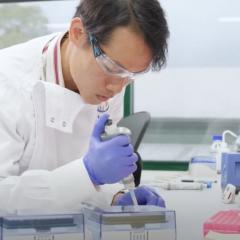The University of Queensland Centre for Clinical Research has received almost $60,000 in funding from the Diabetes Australia Research Trust for innovative research to improve the detection and treatment of gestational diabetes in pregnant women.
Gestational Diabetes Mellitus (GDM) is a condition where women develop diabetes for the first time during pregnancy, exposing mother and baby to a higher risk of complications including high blood pressure (preeclampsia) and pre-term birth.
Nel Peiris, a PhD student at UQCCR, said the Australia-first research aims to understand how a protein called myostatin – a protein produced by the human placenta – affects women with and without gestational diabetes.
“By understanding the role of myostatin in placenta we hope this will lead to the development of better diagnostic tools and novel therapeutics that will help detect and treat women with gestational diabetes,” Ms Nel Peiris said.
Prior studies indicate that myostatin may be involved in regulating how the body uses energy, as researchers found higher concentrations of myostatin in people with metabolic disorders including type II diabetes and obesity.
Myostatin increases the uptake of glucose by the placenta and therefore may be involved in regulating the supply of energy (i.e. glucose) and nutrients to the developing foetus.
“We aim to compare the concentration of myostatin (and molecules involved in the regulation of myostatin) in the placenta of women with and without Gestational Diabetes Mellitus and to identify the possible role myostatin plays in the development and function of the placenta in women with GDM,” she said.
“Very few studies have been performed on myostatin in the placenta of women complicated with GDM or any other complications in pregnancy,”
The Diabetes Australia Research Trust support will allow for the first study of myostatin in the placenta of pregnancies complicated with GDM to be undertaken in Australia.
In Australia, 5-15% of pregnancies are affected by GDM and children whose mother’s develop the condition during their gestation have a higher risk of developing diabetes and becoming obese.
Media contact: Shannah O’Brien (Marketing Communications Officer (UQCCR), 07 3346 6041 or s.obrien13@uq.edu.au).



